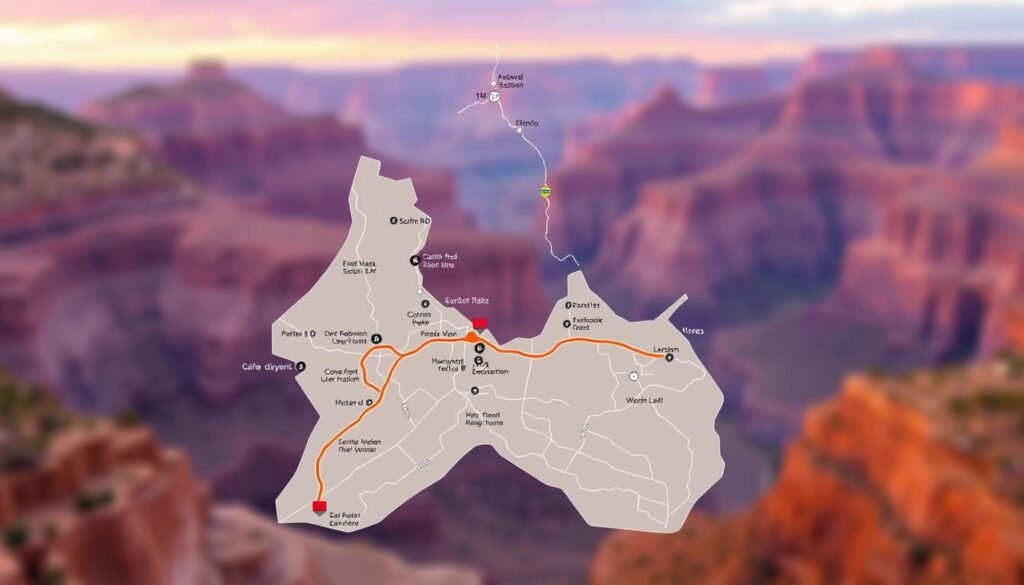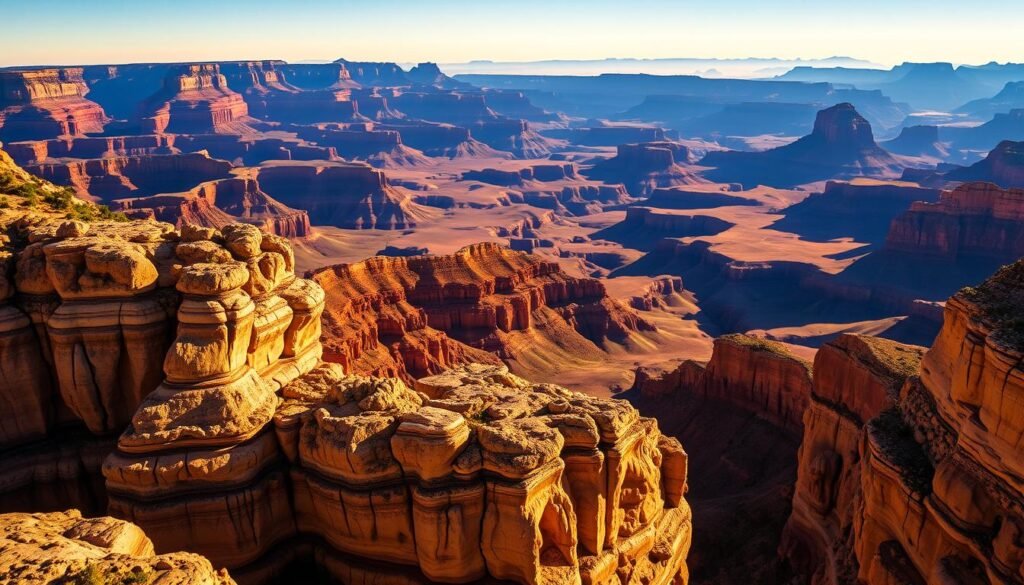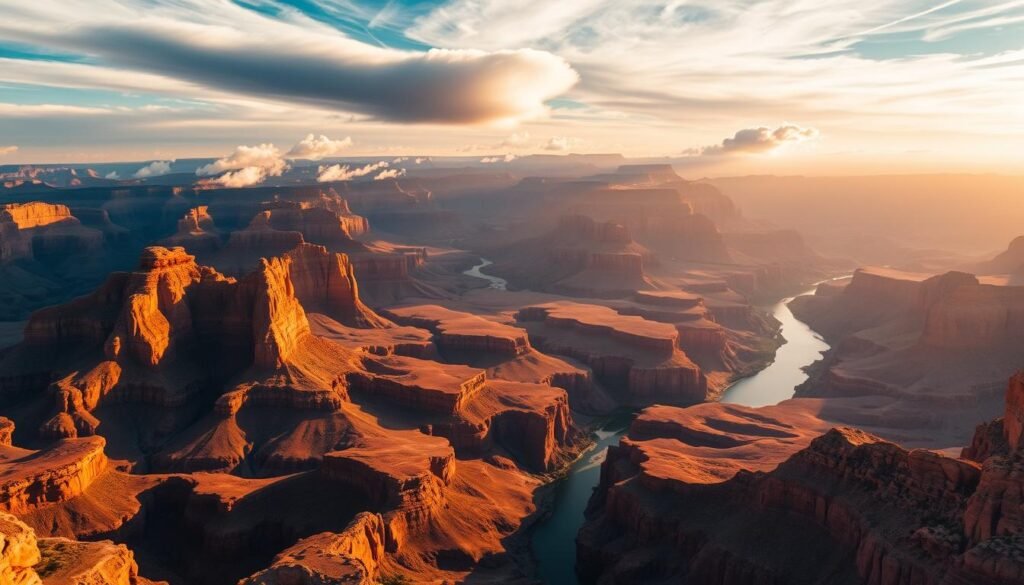Did you know lodging near the park often books 9–12 months ahead during peak months? I learned that the hard way, and it changed how I plan every trip.
I use my priorities — cooler weather, lighter crowds, or peak-season energy — to pick when I go. Spring and fall bring calm trails and easier lodging, while summer packs in visitors and long lines.
The South Rim stays open all year, which makes planning simpler for first-timers. I lean on shuttle schedules, road access, and popular viewpoints so I spend time enjoying views rather than racing the clock.
I also watch broad weather patterns. They shape sunrise and sunset color, trail conditions, and how I set daily itineraries without overpacking the day. For families, I start with simple walks and rim overlooks before tackling longer hikes.
Key Takeaways
- Plan early for peak season lodging; book many months ahead.
- Shoulder months offer cooler weather and fewer crowds.
- The South Rim provides year-round access and more amenities.
- Match your trip goals to the season for better views and trail conditions.
- Start easy: use viewpoints and short walks if you’re new or with family.
How I Decide the Best Time for My Grand Canyon Trip
My planning starts with a short priorities list: ideal weather, easy viewpoints, and realistic hikes that fit my energy for the day.
I then sort those priorities against expected crowds and daylight. I favor shoulder windows when I can, since they give good light and fewer lines without losing the canyon’s scale.
Balancing weather, viewpoints, and hiking plans
I honestly assess how far I’ll hike and what the forecast might do to pace. If temperatures could slow me, I pick shorter loops and extra rest breaks.
Choosing smaller crowds without sacrificing views
I map shuttle routes and link several overlooks in one pass. That way I save energy and still get classic views. I also plan kid-friendly stops first so families enjoy the rim before longer walks.
“I rank my priorities early and keep backup viewpoints in case weather or smoke shifts the light.”
- List priorities (weather, viewpoints, hiking).
- Check daylight and shuttle options.
- Pick a practical route and a backup plan.
| Priority | What I look for | Park tip |
|---|---|---|
| Weather | Comfortable mornings, manageable heat | Check forecasts and pack layers |
| Viewpoints | Clear light for photos, easy access | Use shuttle loops to link overlooks |
| Hiking | Distance that matches fitness | Allow extra return time for elevation |
For a quick reference on seasonal patterns, I use a concise season guide before finalizing dates.
Best Time to Visit Grand Canyon: Seasons, Weather, and Crowds
![]()
I plan trips by matching light, trail access, and how busy the rim will feel. That mix guides whether I chase spring calm, summer energy, fall color, or winter quiet.things-to-do-mt
Spring (March–May): Cooler temps, shoulder-season calm
In spring I enjoy cooler weather and thinner crowds. I can link several grand canyon viewpoints in a day and still move easily between overlooks.
Summer (June–August): Peak season energy and peak reservations
Summer brings the most visitors and the most reservations stress. I book lodging 9–12 months ahead and plan afternoons for shade or indoor exhibits when heat peaks.
Fall (September–November): Crisp air, golden light, lighter crowds
Fall gives crisp mornings and rich color. I hike short trails, linger at viewpoints, and find better availability than summer.
Winter: Quiet trails, cold weather, and South Rim access
Winter can be magical on the South Rim. I pack layers, check advisories, and focus on maintained overlooks when snow or ice affects trails.
“I stack days around sunrise and sunset so weather, light, and trail conditions line up for memorable moments.”
South Rim vs North Rim: When I Go and Why It Matters
I decide which rim fits my plan by balancing convenience, solitude, and logistics. That choice shapes my days, from shuttle use to how far I drive.new-orleans-things-to-do
South Rim: Open year-round with the most amenities and viewpoints
I generally pick the south rim when I want easy access, lots of viewpoints, and services that simplify a family-friendly adventure. Shuttles, tours, and dining keep days flexible and low-stress.
North Rim: Cooler, quieter, mid-May to mid-October season
The North Rim attracts me when I need cooler air and fewer people. It runs roughly mid-May through mid-October and has limited services at higher elevation.
Travel time reality: About five hours driving rim-to-rim
Driving rim-to-rim is not quick. I plan ~five hours and route through Flagstaff or Cameron. I rarely try both rims in one day.
Rim-to-rim hiking: For experienced hikers only
I view rim-to-rim hiking as a serious objective. If I attempt it, I train, secure permits, and plan logistics carefully.You can see best-places-to-visit-in-costa-rica
“I let the season and my energy dictate which side I explore.”
- South rim: year-round access, more services.
- North rim: quieter, seasonal window for solitude.
- Logistics: allow driving time and respect elevation differences.
Reservations, Transportation, and Park Logistics for Each Season

My first step is practical: secure where I’ll sleep and how I’ll move around the park. Summer fills lodging fast, so I lock in reservations nine to twelve months ahead for the busiest dates.
Campground choices shape my plan. I reserve Mather Campground or the North Rim Campground when possible. Desert View is first-come, first-served (open mid-April to mid-October). For RV travel, Trailer Village gives full hookups and predictable comfort.
Booking strategy
I book early for peak summer stays near the south rim. That way I avoid last-minute limits and keep my trip flexible.things-to-do-in-burlington-vt
Shuttles and trail access
I rely on free south rim shuttles—the Village (Blue), Kaibab Rim (Orange), Hermit Road (Red), and Tusayan (Purple)—to link overlooks without parking stress.You can see best-places-to-visit-in-march
Trail and cross-rim transit
For hikes I use Hiker’s Express for early access to South Kaibab and plan buffer time for transfers. If I need rim-to-rim travel without driving, the Trans-Canyon Shuttle runs for about $90.
“I let reliable transit and early reservations do the heavy lifting, so I can focus on the views.”
- Check seasonal openings for Desert View and North Rim services in this national park.
- Use the getting around the park page for schedules and updates.
- Allow extra minutes for shuttle hops and scenic stops; it makes the way I travel less rushed.
My Favorite Times of Day and Viewpoints by Season

I plan around light and flow. Sunrise and sunset are non-negotiable for me because golden-hour light makes the canyon glow. I set those stops first, then shape the rest of the day.
Sunrise and sunset: Timing the light for iconic South Rim views
I aim for one or two signature viewpoints each morning and evening. That protects my views and keeps the day relaxed.
I bring a light layer and a warm drink for dawn. Mornings can be brisk in this national park, even when afternoons warm up.
Shoulder-season hikes and family-friendly ways to avoid crowds
In shoulder months I favor short rim walks and shuttle hops. This keeps kids happy and saves energy for another overlook.
- I pick a couple of must-see viewpoints and fill gaps with easy stops.
- If an overlook is crowded, I pivot along the shuttle loop and return later.
- I check wind for tripod stability and pack a celebratory snack for everyone.
“I match hiking ambition to daylight and keep plans flexible—small pivots save a trip.”
For planning tips and seasonal notes, see this season planning guide before you finalize your trip.
Conclusion
I find that choosing the right window for a canyon national park trip shapes every day — from sunrise glow to relaxed afternoons and simpler logistics.things-to-do-for-kids-near-me
I book reservations early for peak dates and lean on shoulder months or winter for quieter viewpoints and easier pacing. If I plan rim-to-rim hiking, I train and arrange permits; if not, I savor the rim views and keep days flexible.
One rim per visit usually gives richer memories than a rushed checklist. Small moves — shuttle use, campground choices, and a final weather check — make canyon national adventures feel effortless and more rewarding.





















